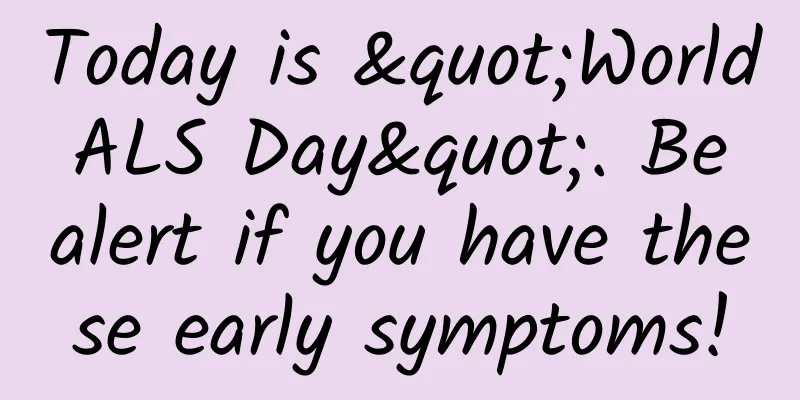Today is "World ALS Day". Be alert if you have these early symptoms!

|
June 21 is World ALS Day. This disease is no stranger to many people. The late famous British physicist Stephen Hawking was once a "patient with ALS". The disease is characterized by gradual muscle atrophy and weakness, and eventually inability to move and paralysis, as if the body is gradually frozen by ice. At present, people have not found a cure for ALS, but early standardized treatment has the positive significance of improving patients' symptoms and delaying the progression of the disease. What is ALS? ALS is the common name for amyotrophic lateral sclerosis, a type of motor neuron disease. Motor neuron disease is a group of chronic progressive neurodegenerative diseases with unknown etiology that selectively invade the anterior horn cells of the spinal cord, brainstem motor neurons, cortical pyramidal cells, and pyramidal tracts (corticospinal tract and corticobulbar tract). Motor neuron disease includes four clinical types: amyotrophic lateral sclerosis (ALS), progressive muscular atrophy, progressive bulbar palsy, and primary lateral sclerosis. Among them, ALS is the most common type of motor neuron disease. Motor neuron disease is mostly sporadic, with an incidence rate of (0.4-2.6)/100,000 per year and a prevalence rate of (4-6)/100,000. The age of onset can range from 10 to 80 years old, but most cases occur after middle age, with an average age of 40-50 years old. The peak age of onset of ALS in my country is around 50 years old, and the age of onset tends to be younger, with a few patients developing the disease at around 20 years old. The incidence rate in men is higher than that in women, with a ratio of (1.5-2):1. As the age of onset increases, this ratio gradually decreases, and the ratio of men to women at the age of 70 is 1:1. Patients with motor neuron disease often die from respiratory failure caused by respiratory muscle paralysis or other complications, usually within 2-5 years. About 10% of patients survive for more than 10 years. ALS that starts with respiratory muscle involvement usually progresses faster and has a significantly shorter survival period. Early diagnosis of ALS should be emphasized ALS usually develops insidiously after middle age and progresses slowly. Clinical manifestations include muscle weakness, muscle atrophy, and fasciculations (muscle twitches), accompanied by hyperreflexia, positive pathological signs, and other signs of simultaneous involvement of upper and lower motor neurons. There is no sensory impairment, and the electromyogram shows typical neurogenic damage, which can usually lead to a clinical diagnosis. Patients often first develop muscle atrophy in the small muscles of the hands, which manifests as clumsy and weak fingers on one or both sides, and then gradually spreads to the forearms, upper arms and other parts, and finally affects the respiratory muscles, leading to respiratory failure. Some patients experience slurred articulation, hoarseness, and difficulty swallowing in the early stages, and are diagnosed with progressive bulbar palsy, which progresses rapidly and has a poor prognosis. At present, there is no cure for ALS, but early standardized treatment can improve symptoms and delay disease progression. In the early diagnosis process, it is necessary to differentiate from a variety of diseases based on different symptoms and signs, such as cervical spondylosis, syringomyelia, multifocal motor neuropathy, Hirayama disease, Kennedy disease, hereditary spastic paraplegia, paraneoplastic syndrome, etc. Take cervical spondylosis as an example. It is a spinal cord disease caused by degeneration of the cervical vertebrae, intervertebral discs or joints, which causes compression of the spinal cord and nerve roots in the corresponding parts. It and ALS are both common in middle-aged and elderly people, and the clinical manifestations are similar. However, cervical spondylosis does not have tongue atrophy and fasciculations, nor does it have bulbar paralysis symptoms such as dysphagia and slurred speech. The sternocleidomastoid electromyography is normal, which can be used as a distinguishing feature from ALS. Clinically, the necessary auxiliary examinations should be selected for different diseases according to the specific manifestations of the patient, and individualized differential diagnosis should be performed. Rehabilitation therapy can improve patients' quality of life Although there is currently no cure for ALS and no specific medication for treatment, rehabilitation treatment can alleviate the patient's pain to a certain extent and maximize the patient's quality of life and independence. 1. Medication Riluzole can delay the progression of ALS to a certain extent and postpone the use of mechanical ventilation. The dosage is 50 mg, taken orally twice a day. Common adverse reactions are fatigue and nausea. Some patients may experience elevated liver alanine aminotransferase, so liver function should be monitored carefully. When patients in the late stage of the disease are already using invasive ventilators to assist breathing, it is not recommended to continue taking the drug. 2. Rehabilitation (1) Physical therapy In the early stage of the disease, patients can still walk and take care of themselves. Rehabilitation treatment is mainly to maintain functional independence and self-care ability, prevent complications such as falls, cramps, pain, etc., and maintain muscle strength. Pay attention to the intensity of muscle strength training and endurance training, and do not fatigue the muscles. Excessive training will lead to muscle fatigue, aggravate muscle weakness and muscle fiber degeneration. The amount of exercise should not affect the daily living ability. In the later stages of the disease, rehabilitation therapy mainly involves guiding patients in transfer, positioning in beds and wheelchairs, and educating patients and their families on passive joint movements and safe and effective mobile rehabilitation. Joint range of motion training can be performed at home as routine treatment. (2) Swallowing therapy In the early stage of the disease, when the patient is able to eat normally, a balanced diet should be adopted. When swallowing is difficult, a high-protein, high-calorie diet should be adopted to ensure nutritional intake. For patients with swallowing dysfunction, food thickeners can be used to complete daily swallowing; swallowing organ-related rehabilitation training can be performed to improve swallowing function; if there is a lot of saliva, a portable suction device can be used to suck out the saliva accumulated in the mouth. In the later stages of the disease, patients can choose nasogastric feeding or intermittent oral esophageal tube feeding or percutaneous endoscopic gastrostomy (PEG). PEG can avoid aspiration caused by food reflux that is prone to occur when using a nasogastric tube, reduce lung infections, and most patients respond well after placement. It is reported that the survival time of patients with PEG placement is significantly prolonged. (3) Treatment of dysarthria In the early stages of the disease, the main symptoms of the patient are soft palate weakness, inability to close the lips, and difficulty in tongue movement. The patient can be trained to slow down the speech speed, increase pauses, and only say key words to improve speech clarity and improve breathing function through speech. Tongue muscle, lip muscle and diaphragm muscle strength training should be performed, but attention should be paid to the intensity of the training to avoid excessive fatigue that aggravates muscle weakness. Upper palate lifting training helps reduce nasal sounds. In the later stages of the disease, patients often experience vocal cord paralysis. Rehabilitation treatment mainly involves guiding patients to use non-verbal language communication tools, such as paper, pen or simple writing board, high-tech computers (such as eye trackers, brain-computer interfaces) and other devices to communicate. (4) Respiratory function training In the early stages of the disease, patients can undergo respiratory function training, such as pursed lip breathing, abdominal breathing training, and simple abdominal muscle resistance training, which can effectively delay the decline in respiratory capacity. During training, attention should be paid to the intensity of the training. In the later stages of the disease, when the patient has a lot of respiratory secretions, the secretions are not smooth, the gas exchange is insufficient, the forced vital capacity (FVC) drops to less than 50% of the normal value or drops rapidly, and breathing difficulties occur, artificial respiration should be performed in time to prolong life. (5) Psychotherapy Almost all patients with motor neuron disease will experience anxiety and depression after learning of the diagnosis. Family members should always pay attention to the patient's emotional changes and provide appropriate psychological support. The psychiatry department can be asked to intervene for psychological treatment and, if necessary, use medication. (6) Use of orthotics Muscle weakness can change the biomechanics of joints, making sprains and tendinitis more likely to occur. Various braces can be used to improve function. For example, if the shoulder girdle muscles are weak, a shoulder sling can be used to reduce the traction on local ligaments, nerves, and blood vessels. For patients with distal limb weakness that affects hand function, using a wrist brace to dorsiflex the wrist 30°-35° can improve the grasping function. The universal cuff can help patients who cannot grasp complete tasks such as typing or feeding themselves. Weakness of the cervical and spinal extensor muscles often leads to head droop and trunk flexion, requiring a neck brace or head support. Falls often occur when the lower limbs are weak, and falls are more dangerous when the upper limbs are weak at the same time. Lower limb braces can be worn to reduce the occurrence of falls. The disease gradually progresses, and walking crutches, hand crutches, walkers, and eventually a wheelchair are required. Even if the patient can still walk, it is recommended to use a wheelchair intermittently to reduce energy consumption. Author: Hu Xueyan: Deputy Chief Physician of the First Department of Neurorehabilitation, Beijing Boai Hospital, China Rehabilitation Research Center |
<<: How do people with diabetes choose rice dumplings?
Recommend
What medicine is good for uterine cyst?
Female friends are often threatened and harmed by...
Tencent: 2Q21 earnings minutes: There is a relevant framework for future supervision, and supervision will not affect the company's long-term business development
On August 19, 2021, Tencent released its second q...
Effects of prolonged sitting during pregnancy on the fetus
Pregnant women should try to keep their bodies in...
What is the cause of frequent urination after abortion?
After an abortion, a woman's body is relative...
Is it good to eat dragon fruit after abortion?
Abortion is a method that women choose when they ...
What should I do if I feel nauseous 9 days after having sex?
Although modern society is more open than before,...
What should I do if my cesarean section wound is itchy?
Mothers who have had a cesarean section will know...
What medicine can eliminate uterine polyps?
The incidence of uterine intrauterine polyps in d...
How big is the ovarian follicle suitable for intercourse?
In order to get pregnant, you must first have hea...
Can I still use the oyster if it is moldy on the surface? What is oyster oil used for?
Oyster sauce is a traditional umami seasoning com...
Snoring is caused by poor breathing. How is breathing achieved? What is the principle of a ventilator?
For humans, there is one thing that is most impor...
How to judge polycystic ovary syndrome with six hormone tests?
Hormones are important substances in the body. Th...
Will I always bleed if I continue to remove blood stasis from my lower abdomen after medical abortion?
Medical abortion involves prolonged bleeding as t...
What is milky vaginal discharge?
When a girl reaches puberty, the ovarian function...









